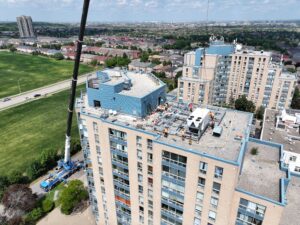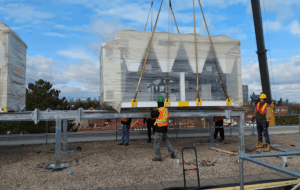Guiding Existing Buildings to Net Zero Emissions
Projects Sponsor
With buildings responsible for approximately 51% of Peel Region’s corporate emissions, the Office of Climate Change and Energy Management launched a bold and innovative initiative in 2023. They developed a Net Zero Emissions (NZE) Building Retrofit Standard—a first-of-its-kind framework to guide their existing buildings toward NZE in a streamlined and cost-effective way. Approved by the Regional Council in 2025, the Standard is a pioneering step to achieve Peel’s 2030 target of a 45% GHG reduction from 2010 levels. Its implementation is projected to cut 48,000 tonnes of GHG emissions by 2050, equivalent to the impact of planting 2 million trees. That’s an a-Peel-ing prospect.
Peel Region’s ambitious Climate Change Master Plan (CCMP) established a corporate GHG emissions reduction target of 45% reduction by 2030 compared to 2010 levels. With buildings responsible for approximately 51% of Peel’s total corporate emissions, decarbonizing the existing building stock is essential to achieving this target and was seen as a priority. What was missing was a standardized, cost-effective, and scalable approach to guide deep energy retrofits across Peel’s diverse portfolio of facilities.

To address this gap, the Office of Climate change and Energy Management (OCCEM) developed a Corporate Net Zero Emissions (NZE) Building Retrofit (BR) Standard and Policy for existing corporate buildings and facilities. This initiative provides a clear, consistent pathway to transition existing buildings to NZE while balancing carbon performance, lifecycle cost, and operational feasibility.
The electrification of all-natural gas fired building systems at the end of their useful life was identified as key. Running out of gas, then selecting fuel switching and energy efficiency measures based on life cycle cost and carbon analysis going forward and then attaining CaGBC ZCB Performance certification for all fully electrified buildings was the plan.
Enhancing building performance was also a priority. This would save money and reduce GHG emissions while improving occupant health, safety, and comfort. Integrating all measures with existing asset management plans for long-term impact would provide a different kind of comfort.
As part of the development of the NZE BR Standard, a comprehensive scan of approximately nine existing building standards was conducted to identify relevant frameworks and best practices. This research was critical in establishing a foundation for a standard tailored to the needs of Peel Region.
The review showed that none of the existing standards directly aligned with the approach required by Peel. Most notably, they lacked the ability to provide guidance on what specific actions to take when an intervention is needed. While many standards provided general principles or long-term goals, they did not offer actionable performance targets or clear direction for individual decarbonization interventions—an essential component for Peel’s strategy.
This insight underscored the need for a new, purpose-built standard and NZE BR Standard was designed to fill this gap by offering practical, performance-based guidance that supports decision-making at the project level.
This work not only demonstrates Peel’s leadership in sustainability but also sets a precedent for other jurisdictions seeking to decarbonize their existing building stock in a structured, actionable way.
Following the initial market research, a project roadmap that aligned with Peel Region’s CCMP and long-term asset management strategies was developed. This process also involved collaboration with a technical working group, which included all internal program areas that operate and provide asset management services to Region-owned buildings. This would help ensure that the standard is integrated into existing workflows.
OCCEM then worked with technical consultants (Introba) to model various retrofit scenarios. Using lifecycle cost and carbon analysis tools, the team evaluated how different decarbonization strategies would impact key metrics, including energy and GHG emissions savings, present cost, and incremental first costs.
The scenarios explored were business-as-planned, highest performance, and low-cost electrification. The results informed the development of a tiered decision-making framework that prioritized electrification, fuel switching, and energy efficiency upgrades based on performance and cost-effectiveness.
Following completion of the NZE BR Standard and Policy development, it was endorsed by the project steering committee and presented to Peel’s Executive Leadership Team. Approval by Peel Regional Council then came in 2025.
The Standard is now officially embedded into Peel’s capital planning process, ensuring that all major building system replacements align with the organization’s climate goals. This structured, policy-driven approach ensures consistent application across Peel’s building portfolio.
 One of the biggest challenges in developing the NZE BR Standard was aligning the ambitious climate goals with the practical realities of capital planning, asset management, and budget constraints. Many of Peel Region’s existing buildings were not originally designed with electrification or deep energy retrofits in mind, making it difficult to apply a uniform approach.
One of the biggest challenges in developing the NZE BR Standard was aligning the ambitious climate goals with the practical realities of capital planning, asset management, and budget constraints. Many of Peel Region’s existing buildings were not originally designed with electrification or deep energy retrofits in mind, making it difficult to apply a uniform approach.
To address this, flexible compliance paths were included, allowing a choice between default decarbonization solutions or custom approaches based on carbon and cost analysis. This flexibility ensures that the Standard can be applied across a diverse building portfolio while still driving meaningful emissions reductions.
Another key obstacle was balancing carbon performance with cost efficiency. While the goal was to maximize GHG reductions, Peel also needed to ensure that retrofit measures were financially viable and aligned with long-term asset renewal cycles. This led to the development of a robust lifecycle cost and carbon analysis which supports informed decision-making.
The NZE BR Standard and Policy is driving a fundamental shift in how Peel—and potentially other jurisdictions—approaches building decarbonization. By embedding climate action into project planning and decision-making, the NZE BR has transformed how Peel plans, prioritizes, and invests in low-carbon building retrofits.
The Standard has brought together internal stakeholders under a unified framework, fostering cross-departmental collaboration and shared accountability for climate goals. The development and rollout of the NZE BR Standard have already led to increased technical literacy among staff and stakeholders.
By formalizing a clear, performance-based approach to retrofits, the Standard sends a strong signal to the building industry, consultants, and contractors. It outlines expectations for carbon performance and cost-effectiveness, encouraging innovation and alignment with low-carbon solutions in the private sector.
To test and prove the applicability of the NZE BR Standard, Peel Region has five major retrofit projects underway—all of which align with the Standard while it was being developed. Peel is demonstrating its commitment to decarbonize its building portfolio in real time. These projects are expected to reduce 1,725 tonnes of GHG emissions per year, improve building performance, reduce operational costs, and make the people inside them more comfortable.
There’s a lot that’s a-Peeling about that.













